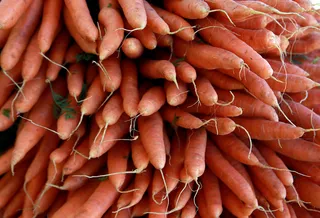Food for Thought: Fall and Winter Gardening Tips
Cultivate your green thumb during the cold months.

1 / 8
Think Green - With the announcement that First Lady Michelle Obama will be releasing a gardening book, now is a great time to learn how to grow your own food at home. Although American Grown: How the White House Kitchen Garden Inspires Families, Schools and Communities won’t be released until next spring, there are ways you can begin cultivating your green thumb right now. Yes, even with the cold temperatures looming.(Photo: Crown Publishing)

2 / 8
Get Started - First, figure out the gardening zone, or USDA Hardiness Zone, as well as the Sunset Climate Zone for your area in the country. Knowing what climate and conditions you reside in will help you figure out what plants will do best in your garden. Many plants will come with tabs saying what zones they’re suited for. If not, ask the store owner for suggestions. (Photo: Justin Sullivan/Getty Images)

3 / 8
Mark Your Territory - If planting outdoors, use a well-insulated cold frame to keep crop temperatures stable and warmer against frost and wind. A hot bed is a cold frame with a heat source beneath the box to keep the soil free of frost. Planting crops on a raised bed will also be helpful if your area receives a lot of rain during the winter. (Photo: Sean Gallup/Getty Images)

4 / 8
Dig Deep - Try planting hardy greens such as lettuce, chard, kale and parsley that can withstand the low temperatures. You can start seedlings indoors, and then continue growing them outside in a cold frame.(Photo: Sean Gallup/Getty Images)

5 / 8
Growing Plants - Or learn how to grow salad options like spinach, arugula and radishes entirely inside. Use a grow light, about 12 to 14 hours a day, to make sure they receive ample light to grow. (Photo: St. Louis Post-Dispatch/MCT/Landov)
ADVERTISEMENT

6 / 8
More the Merrier - Rhubarb and carrots (and other root vegetables) also fare well during the winter months. (Photo: Matt Cardy/Getty Images)
Photo By Photo: Matt Cardy/Getty Images

7 / 8
Garden Windows - Create a kitchen garden full of herbs like chives, parsley, basil and thyme right on your window sill. Just make sure they get at least five hours of sunlight a day (or use fluorescent lights or an indoor grow light), to monitor its moisture as indoor air can get too dry. Fight off insects by bathing or spritzing the plants with soapy water. When ready to harvest, snip often to encourage growth, but not more than a third off the plant at a time. (Photo: Alex Wong/Getty Images)
